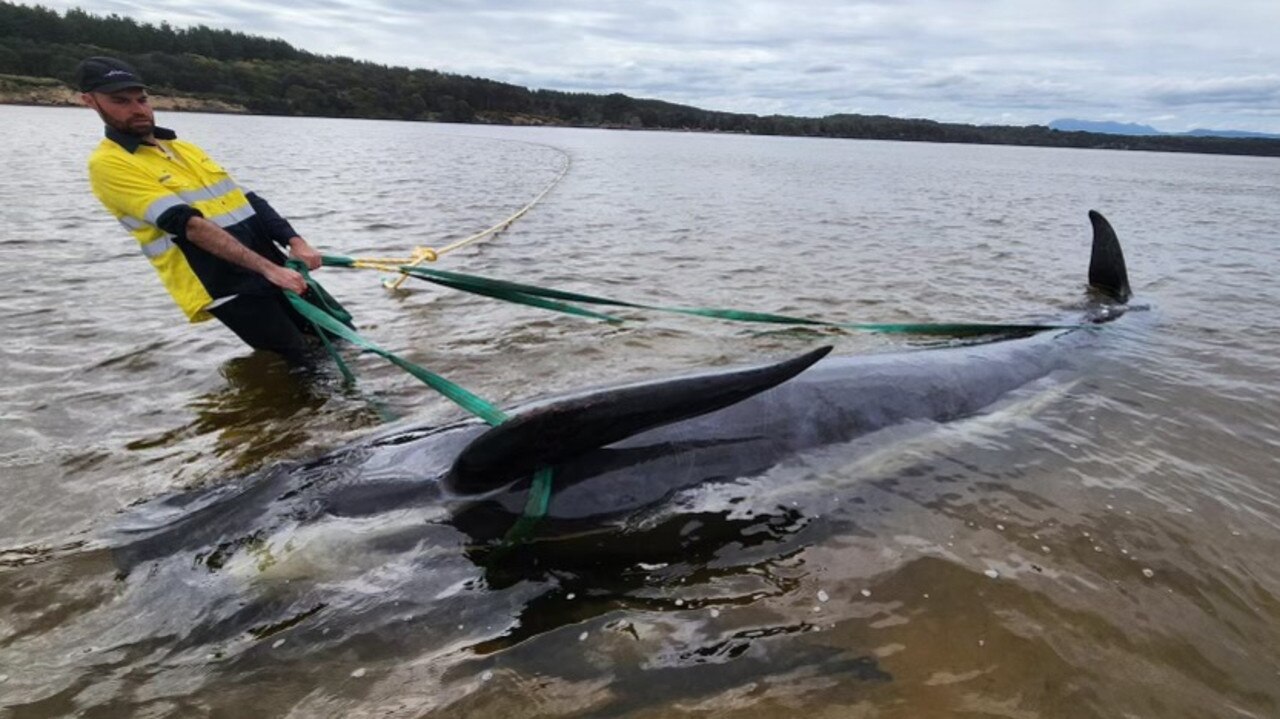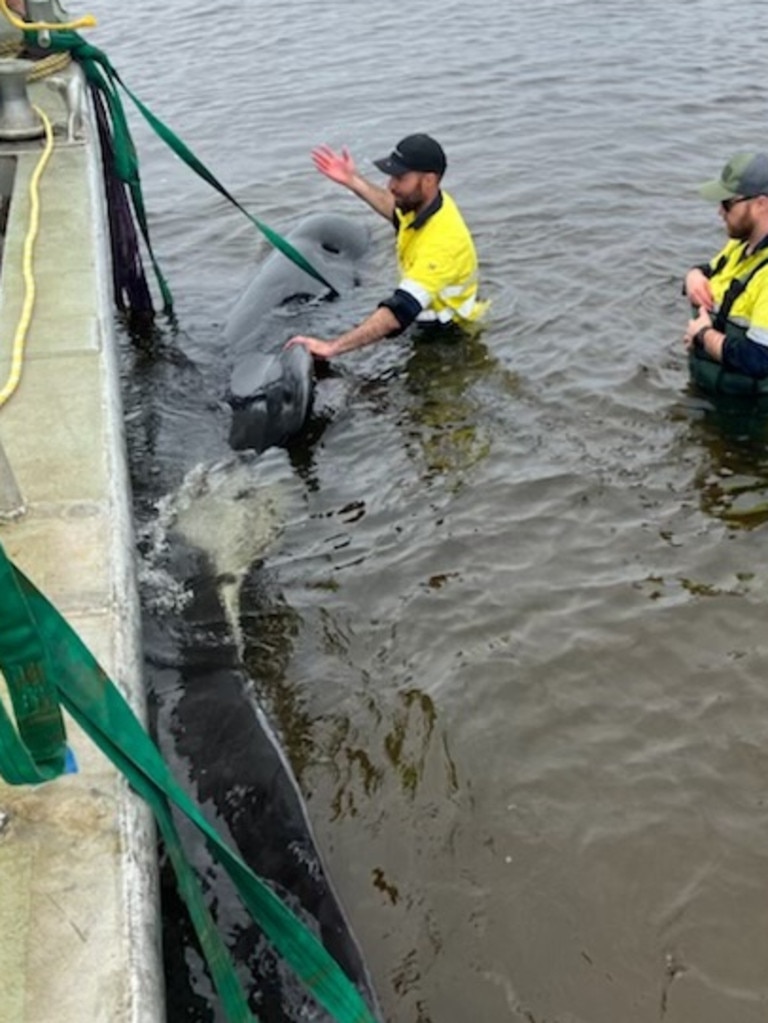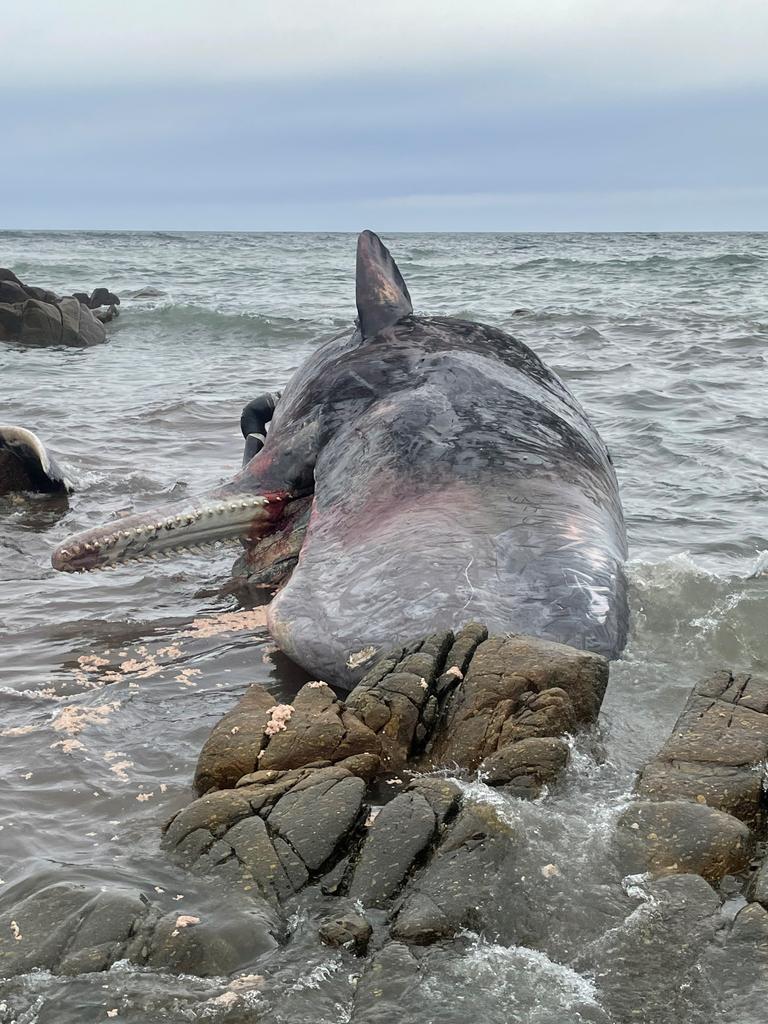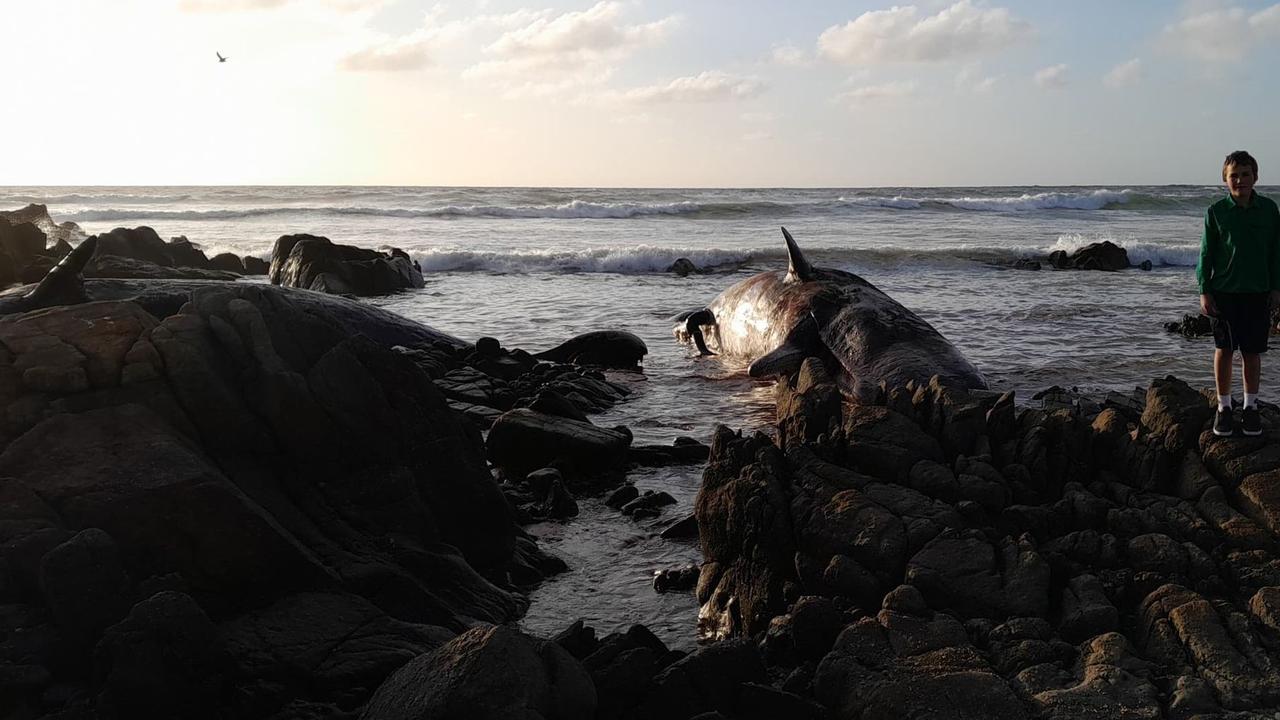Mass whale stranding near Macquarie Harbour, Tasmania
Baby pilot whales are among a pod of about 230 beached in the same spot as the massive stranding event in 2020 — with authorities rushing to save the ones still alive. Latest photos and videos from the scene.
At least 10 baby whales have been among the 230 which were beached in a mass stranding at Macquarie Harbour.
Zone manager for Huon Aquaculture for Strahan Linton Kringle was one of the first on scene 200-300m north of Hells Gate.
He said there were at least 10 baby whales.
“Fairly small ones, probably a metre and a half long, maybe 150kg … they’re scattered in between the big ones,” Mr Kringle said.

“Including the bigger ones we counted 230, there’s probably a few more, it’s difficult to get an accurate count at the moment.
“There’s quite a few of them still alive, it’s been such a hard place to get them back out at the moment.”
Huon Acquaculture workers counted 233 on Ocean Beach and more were inside the harbour on the other side of the channel.
Petuna Aquaculture workers were helping to rescue whales trapped inside Macquarie Harbour.
Mr Kringle said it had been a long day trying to refloat the whales.
“We were the first at the scene, we didn’t have any gear or anything,” Mr Kringle said.
“Trying to spin the ones that could handle it out into the waves, that’s all we could really do.”
He said it would be a delicate rescue.

“Because it’s on the beach it’s a lot harder, the beach is so rough and really remote, hard to get on to,” Mr Kringle said.
“We just can’t drive boats on to the beach because of the waves.

“It’s sort of tricky, I’m thinking most of our efforts will be with vehicles, I would assume a lot will be with off road vehicles.”
Mr Kringle said it would likely be a long night to keep whales alive.

“Their skin’s really fragile, they get sunburnt really easily, it’s a matter of keeping sheets on them and keeping them wet and making sure their blow hole’s not obstructed so they can breathe,” Mr Kringle said.
“I reckon people will be working through the night, whether we can refloat any is going to depend on the tides and how much the waves ease up, there could be people there all night.”
Mr Kringle was also involved in the rescue of whales in a mass stranding two years ago.
“For me, it’s a bit heartbreaking to see them do that, especially two years to the day … I was involved really heavily with the first rescue two years ago,” Mr Kringle said.
“I don’t know why they do it.
“To see it happen again, it’s weird.”

EARLIER:
Marine conservation experts are heading to Tasmania’s West Coast, where a pod of about 230 whales has stranded near Macquarie Harbour.
The animals, which the Department of Natural Resources and Environment say appear to be pilot whales, are stranded on Ocean Beach — the same spot as the mass stranding of 2020.
This time, a number of pilot whales are stranded on a sand flat inside Macquarie Harbour and it appears about half the animals are alive.

It’s exactly two years to the day since the largest whale stranding in Australia’s history happened at nearby Strahan happened on September 21, 2020, with almost 400 whales being killed.
A team from the DNRE Marine Conservation Program is assembling whale rescue gear and heading to the area and will work alongside Tasmania Parks and Wildlife Service staff and Tasmanian Police at Strahan.
“The department has a comprehensive Cetacean Incident Manual which has undergone extensive review since the 2020 mass stranding and which guides a stranding response,” a department spokesperson said.
“Marine wildlife experts will assess the scene and the situation to plan an appropriate response. Stranding response in this area is complex. If it is determined there is a need for help from the general public, a request will be made through various avenues.
“Whales are a protected species, even once deceased, and it is an offence to interfere with a carcass.”
EARLIER:
Authorities are on their way to another mass whale stranding on the west coast of Tasmania, with reportedly hundreds of mammals involved.
It’s understood the stranding has occurred near Macquarie Harbour, south of Strahan.

It’s exactly two years to the day since the largest whale stranding in Australia’s history happened at nearby Strahan happened on September 21, 2020, with almost 400 whales being killed.
The Department of Natural Resources and Environment Tasmania confirmed they are responding to the stranding.
It comes just one day after reports of a pod of 14 young sperm whales washed ashore on King Island.
The West Coast Council has closed the Macquarie Heads Road and campground to the public until further notice.

MORE TO COME
Theory behind whale stranding
Misadventure could be the reasons behind a mass stranding of sperm whales on King Island, a wildlife biologist says.
The 14 young male whales were found dead in the vicinity of Whalebone Beach on Monday afternoon.
Marine Conservation Project wildlife biologist Kris Carlyon said it was unclear exactly when the whales died, but that the carcasses appeared to be “quite fresh”.
“My understanding is it likely occurred on the night of the 18th, that’s purely going on the presentation of the animals,” Dr Carlyon said.

A team of biologists and a veterinarian are on site and collecting samples from the deceased whales.
“Hopefully those post-mortems will give us clues as to why they becomes beached,” Dr Carlyon said.
“The most common reason for stranding events is misadventure, they might have been foraging close to shore, there might have been food and possibly they were caught on a low tide,” Dr Carlyon said.
“That’s the theory at the moment.”

An aerial search was conducted to locate any other whales which may have been stranded, but none were found.
Dr Carlyon said it was unexpected to see sperm whales hanging around King Island and some might have been “semi residents” in Tasmanian waters.
He said mass beachings were uncommon.
“It’s infrequent but certainly not unexpected,” Dr Carlyon said.
“Tasmania is one of the world’s hot spots for beaching, likely due to our proximity to the continental shelf.
“It’s not unexpected we might see sperm whales hanging around near King Island.
“Of all the species that strand in Australia, sperm whales are more common.”
Dr Carlyon said it was a sad event, but researchers would make the most of the tragedy.
“It’s a very sad event, I guess it’s also an extremely valuable experience for us to see these animals up close to take sample,” he said.
“It’s an opportunity for science, to learn more and learn why they might have stranded.
Mass whale stranding on King Island as at least 14 found dead
Wildlife investigators have been sent to King Island after at least 14 young sperm whales became stranded.
King Island resident Sarah Baldock came across the horrific sight on Monday afternoon.
“A friend stopped in home yesterday afternoon and had let us know (about the whales). We decided to take the children for a look — as sad as it is it’s nice that kids get to understand the size of some of the ocean’s creatures,” she said.
“The police and parks and wildlife were already there when we arrived.”
Ms Baldock said the deceased whales were at the local beach fishing area known as Strickys/Whalebone Bay.
“Unfortunately (this stranding) is not the first time for here … although they’re the largest whales I have seen washed up,” she said.
Almost two years ago, Tasmania saw the biggest whale stranding event in history after more than 250 pilot whales died having washed ashore on the west coast.

The Department of Natural Resources and Environment Tasmania said the sperm whales were all young males and were dead at the time it was reported.
“Marine Conservation Program (MCP) wildlife biologists and a vet are travelling to the island to conduct investigations including necropsy where possible and collect valuable samples,” an NRE spokesperson said.
“MCP will also carry out an aerial inspection to determine if there are any other whales in the area.
“Parks and Wildlife Service (PWS) staff are on site monitoring the situation.”
The spokesperson said it was possible the whales were travelling together.
“It is not unusual for sperm whales to be sighted in Tasmania and the area the whales have stranded is within the normal range and habitat for sperm whales,” they said.
“While further inquiries are yet to be carried out, it is possible the whales were part of the same bachelor pod – a group of younger male sperm whales associating together after leaving the maternal group.”
Surfers, swimmers or anyone who sees stranded whales are urged to keep their distance as carcasses can attract sharks.
The spokesperson said it was an offence to interfere with protected wildlife or be in possession of parts of a dead whale.
Whale sightings can be reported to 0427 WHALES.




